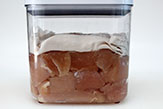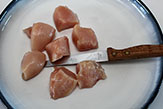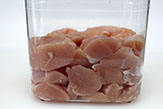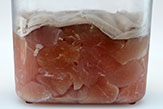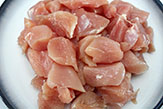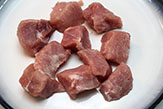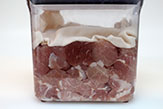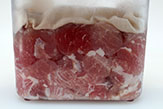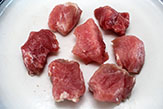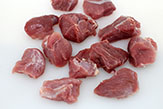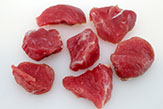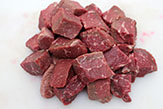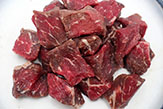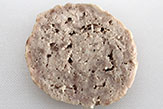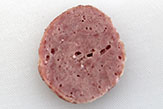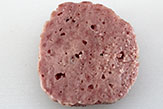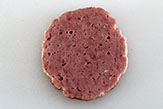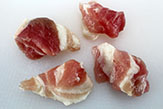Meats and Sausages
Curing Meat for Sausages
The best sausages in Europe were made in years 1950-1990. Raw meat materials were cured first with salt and potassium nitrate or sodium nitrite and then ground, stuffed into casings and sausages were smoked and cooked. Whole meats such as loins, butts, hams and bellies were cured whole and then smoked. Meat processing plant had a curing department where meat trimmings of different grades were mixed with salt and nitrite, labelled and cured. In countries such as Germany, Poland or Russia the majority of processed meats have been of smoked variety.
Today, curing is done with curing accelerators, pump injectors and meat tumblers in order to save time, space and ultimately the money. Unfortunately, in order to shorten curing time we have to introduce curing accelerators, flavor and color enhancers and many other chemicals. The products look pretty and are packed nicely, however, the flavor of presently processed meats don’t come close to products that were made in the past.
Let make something absolutely clear, you don’t need to cure meat to make a sausage, however, it will be a much better product if the meat has been cured. Curing is an extra process that requires more time, designated containers and a space in a refrigerator. The reason we advocate the curing procedure is that the highest quality smoked sausages are made from meat that has been cured.
Curing flavor
Curing develops a peculiar curing flavor which is in demand by the knowledgeable consumer. Before you even bite a slice of traditionally cured smoked ham or sausage you will smell a certain peculiar aroma. It is called the curing flavor and it can only be developed when salt and sodium nitrite (Cure #1) are given sufficient time to react with meat. With curing accelerators, the red color can be developed by the time the sausage is smoked and cooked, but more time is needed to develop the curing flavor. You will never sense it in commercially produced product which are fast cured. If we cure hams, bacon, chops, butts, and fish because they taste better, so why not cure meat for sausages? The fact that we grind meat makes it only easier on our teeth to chew it - it does not improve the color, texture or the flavor of the sausage. Someone might say: but I have mixed nitrite and spices with ground meat before stuffing so that’s OK. Well, it’s not ok, the problem is that not enough time was allocated and the sausage is only partially cured. It is red, plump, it has smoky flavor, but the curing flavor is not there.
The dry method of curing is used to cure meat for sausages. Meat should be cut into smaller pieces, about 2 inches (5-6 cm) and not heavier than 0.5 lb (250 g). Meat should be thoroughly mixed with salt, Cure #1 (salt, nitrite), sugar (if used) and packed tightly in a container, not higher than 8 inches (20 cm). Going higher increases pressure and slows down curing. Then the meat is covered with a clean cloth and stored in a refrigerator. There are chemical reactions taking place inside meat and the cloth allows the gases to evaporate through. It also prevents the surface of the meat from reacting with oxygen which sometimes creates gray color areas on the surface. This is normal, the meat is fine and there is nothing to worry about. The container does not need to be covered as there are not any unpleasant odors present.
The curing times at 40° F (4° C) (refrigerator temperature) are as follows:
- Meat pieces size 2” - 72 hours.
- Ground meat - 24 - 36 hours, depending on a plate size.
With the use of ascorbates and erythorbates it is possible to cure meats at even lower temperatures, which is commonly practiced by commercial establishments.
After meat cuts are cured they are ground, mixed with spices and stuffed into casings. Salt is not added as it has been added during curing step.
What will happen to smoked sausages if the meat is not cured? Basically nothing as long as you add salt and Cure #1 (sodium nitrite) to ground meat during mixing. You are still curing meat, however, the curing time is much shorter. The final color might not be as good as the properly cured sausage but it will still be a great sausage. If you don’t want to cure meat using the traditional method, use the alternative curing method described below.
The curing time depends on:
- Diameter of the meat - making cuts smaller or grinding them in a grinder increases the meat’s surface area and speeds up curing.
- Temperature - usually set by the refrigerator setting. In the past when Nitrates were used, curing temperatures were higher (42-46° F, 6-8° C) which allowed curing bacteria to react with Nitrate. As a result nitrite was released which would then cure meat.
- Additives - adding ascorbates speeds up curing. More important for commercial producers.
Alternative Curing Methods
Method 1. Grind each meat through a proper plate (as dictated by the recipe). The reason that we grind now and not cut meat into pieces for curing is that salt and sodium nitrite will penetrate a tiny piece of ground meat much faster than a 5 cm (2”) cube. Mix meat with salt and Cure #1. Pack tightly (to remove air) and separately, place each type of ground meat in a container and cover with a cloth to allow breathing. Let it “set” for 3-4 hours at room temperature 20-22°C (68-71°F). Chemical reactions proceed much faster at higher temperatures and so does curing. Add spices, mix all together and stuff casings.
Method 2. Grind each meat through a proper plate (as dictated by the recipe). Mix meat with salt, Cure #1 and other ingredients. Stuff sausages and place in a cooler for 12-24 hours before smoking. When removed from a cooler they have to be conditioned at room temperature for a few hours to remove moisture from the surface.
Method 3. Grind each meat through a proper plate (as dictated by the recipe). Mix meat with salt, Cure #1 and other ingredients. Stuff sausages and hang at room temperature for 2 hours. Transfer to a smokehouse.
When ground meat is mixed with sodium nitrite (cure 1) the reaction is almost instantaneous and pink color results fast. The time is shortest when meat is minced with the smallest grinder plate. In the images that follow pork meat (80% lean, 20% fat) was ground with 1/8" (3 mm) grinder plate. After curing the samples were cooked.
Simple Test
Although there is not much difference in color, nevertheless, cure ground meat for 24 hours if you can. Curing not only develops pink color, but also a characteristic curing flavor. Make two meat balls, one cured with salt only and another with salt and sodium nitrite (cure 1). Hold them for a few hours in a refrigerator and then boil in water for 20 minutes. Let them cool, then smell and taste both meat balls. The one cured with nitrite will have a wonderful aroma, better taste, texture and color.
As you can see in all instances we are buying extra time to allow curing inside the meat. A commercial producer will not perform curing at higher than cooler temperature as this will affect the shelf life of the product. Commercial processors cure meat faster and at lower temperatures by using ascorbic acid, erythorbic acid, or their derivatives, sodium ascorbate and/or sodium erythorbate. These additives speed up the chemical conversion of nitrite to nitric oxide which in turn will react with meat myoglobin to create a pink color. They also deplete levels of meat oxygen which prevents the fading of the cured meat color in the presence of light and oxygen.
Bear in mind that fast curing methods cannot be used when curing whole pieces like hams, butts or loins unless commercial curing methods are introduced (injection, curing accelerators and tumbling). Due to the insufficient curing time the whole meats will exhibit an uneven pink and reddish area or even some gray in it. That would be easily noticeable when slicing those meats. As sausage is made from comminuted meat any variations in color cannot be spotted, unless larger chunks of meat are mixed with finely ground meat.
When making less than 5 pounds of sausage it is perfectly acceptable to make curing a part of the mixing and conditioning process. This way the sausage is stuffed and ready to go into the smoker and all equipment can be washed and put away. When making large amounts of sausage, you may use a few pork butts or picnics and trimming this meat will take a while. Then you have to grind, mix, stuff and smoke sausages. This operation will take many hours. It is feasible to make sausages on two separate occasions:
- The first day - meat selection and trimming. The skin and bones are removed, all sinews, gristle and glands are discarded. Meat is cut into small pieces, mixed with salt and nitrite and placed in a refrigerator for 24 hours. Except the knife no equipment was needed.
- The second day - cured meat goes into the grinder and the sausage making process continues.
Curing Fat
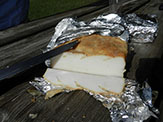
Pure fat like back fat or fat trimmings are salted only. Fat does not contain myoglobin so sodium nitrite (cure 1) has nothing to react with and the color will remain white. However, salting fat changes its structure and softens it. The best example is salted back fat which is easy to eat on its own. It is usually eaten with bread, mustard or a pickle. Salting back fat.
Salting Fat Trimmings
Small fat trimmings are salted with 2% salt (20 g per 1 kg of fat). Mix fat trimmings thoroughly with salt and place in a container for 24-48 hours.

